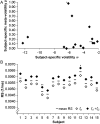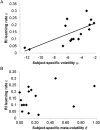Spatial attention, precision, and Bayesian inference: a study of saccadic response speed
- PMID: 23322402
- PMCID: PMC4014178
- DOI: 10.1093/cercor/bhs418
Spatial attention, precision, and Bayesian inference: a study of saccadic response speed
Abstract
Inferring the environment's statistical structure and adapting behavior accordingly is a fundamental modus operandi of the brain. A simple form of this faculty based on spatial attentional orienting can be studied with Posner's location-cueing paradigm in which a cue indicates the target location with a known probability. The present study focuses on a more complex version of this task, where probabilistic context (percentage of cue validity) changes unpredictably over time, thereby creating a volatile environment. Saccadic response speed (RS) was recorded in 15 subjects and used to estimate subject-specific parameters of a Bayesian learning scheme modeling the subjects' trial-by-trial updates of beliefs. Different response models-specifying how computational states translate into observable behavior-were compared using Bayesian model selection. Saccadic RS was most plausibly explained as a function of the precision of the belief about the causes of sensory input. This finding is in accordance with current Bayesian theories of brain function, and specifically with the proposal that spatial attention is mediated by a precision-dependent gain modulation of sensory input. Our results provide empirical support for precision-dependent changes in beliefs about saccade target locations and motivate future neuroimaging and neuropharmacological studies of how Bayesian inference may determine spatial attention.
Keywords: cue validity; hierarchical models; variational Bayes; visuospatial processing; volatility.
Figures









Comment in
-
The Neural Mechanisms of Bayesian Belief Updating.J Neurosci. 2015 Dec 16;35(50):16300-2. doi: 10.1523/JNEUROSCI.3742-15.2015. J Neurosci. 2015. PMID: 26674857 Free PMC article. No abstract available.
References
-
- Anderson AJ, Carpenter RHS. Changes in expectation consequent on experience, modeled by a simple, forgetful neural circuit. J Vis. 2006;6:822–835. - PubMed
-
- Bastos A, Moran R, Litvak V, Fries P, Friston K. A Dynamic Causal Model of how inter-areal synchronization is achieved in canonical microcircuits. 2011. Program No. 622.16. NeuroscienceMeeting Planner. Society for Neuroscience, Washington, DC. (Online)
Publication types
MeSH terms
Grants and funding
LinkOut - more resources
Full Text Sources
Other Literature Sources

